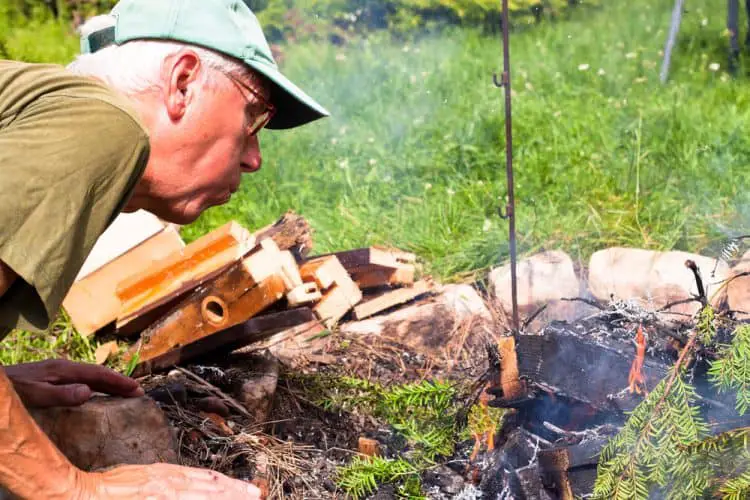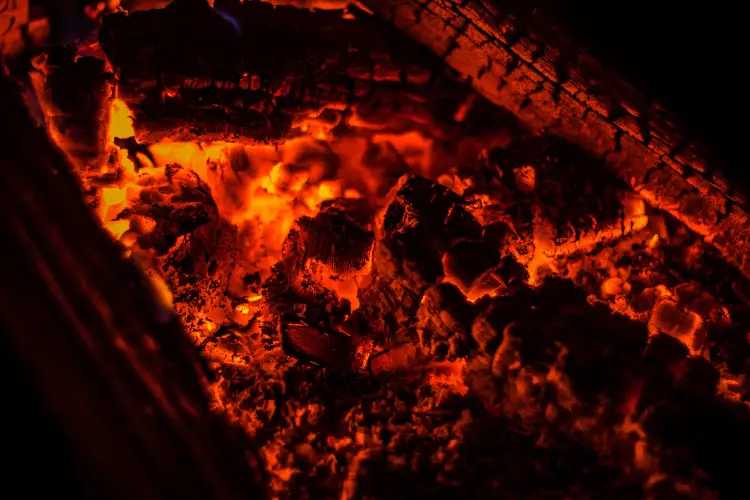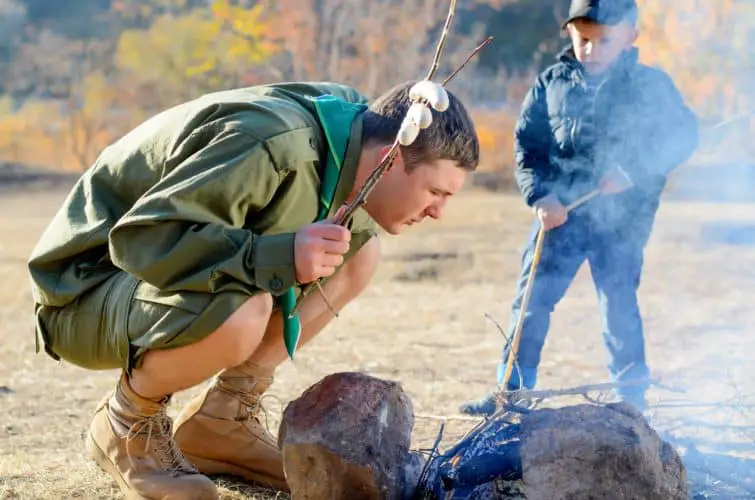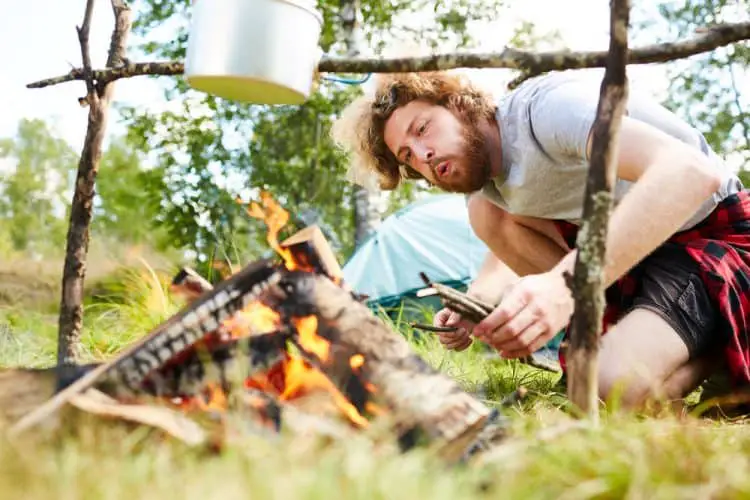Why Does Blowing On A Fire Make It Burn Better? [See Why]
Have you ever seen that one campfire master who gets down on all fours and blows into a fire?
Well, you may have thought that this was a crazy person, but actually they are someone who knows a little bit about lighting a fire.
Just about every time I start a fire, the blowing comes out to really get it going. But, Why does blowing on a fire make it burn better?
When you blow on a fire, more oxygen is inserted into the structure of wood and embers. Not only is oxygen required for fires to burn, but blowing more into them creates pressure on the system that gets those embers really going. Once this has been established, your fire will burn consistently and in a healthy manner.
In this article, we will provide interesting facts by answering the question in more detail.
So, if you want to bring your camping skills to the next level, continue reading.
Let’s begin!
What does blowing on a fire do exactly?
When you blow on a fire, you create a lower pressure system full of oxygen to give the fire the appropriate amount of oxygen to burn well.
When you push oxygen into the structure with the embers or fire, you are feeding it what it needs to thrive.
As you will see later in the blog, a fire needs three things or three elements to burn.
One of the three elements is oxygen. If you have seen someone down blowing before, they are not putting the fire out.
In fact, it is quite the contrary. They are actually shooting oxygen into the fire to maximize the burning power. And that makes it burn longer.
In a sense, you are creating a vacuum to feed the fire when it needs a bit of help. Not every fire will require you to blow on it, but many will.
This vacuum will keep oxygen flowing into it even after you are done blowing. Without blowing in a fire, the whole structure may not be able to get enough oxygen to thrive. Although some will, some definitely need some help at the early stages.
When you blow on the fire, you will almost exclusively do it in the early stages of the fire. This is when creating the vacuum will be the most fruitful.
Why does blowing on a smoldering fire make it burn faster?
When you have a fire that is already smoldering, blowing on it will make it burn hotter and faster.
When you can add more oxygen, you are going to increase the temperature and push it toward the fuel that has yet to catch.
From this, getting a roaring fire going is not far away.
With a smoldering fire, this vacuum is just as apparent and just as important. If the fire is on the verge of dying, having some sort of oxygen source after you are done blowing is crucial.
This is exactly what happens when you put in the work and allow that air to flow well. And the lower pressure you create with your breath helps even more because it's more oxygen-rich.
What is a fire triangle?
If you are new to fire building and the science behind them, the first thing to learn is the fire triangle.
Each point of the fire triangle is required for a fire to be successful.
Heat
A fire needs some sort of ignition to get going and make it burn better and that falls under the heat corner of the triangle.
Generally, this comes in the form of matches, lighters, flint and steel, and anything else used to get the flame started.
Fuel
Then, that heat source needs something to catch onto and feed off of. This is what the fuel is. This is usually wood, leaves, or brush that is stacked up and used to catch the flame of the burning fire.
The better the fuel, the longer and better the flame will burn. Let's get to the second of the three things that make a fire burn.
Oxygen
The final part of the fire triangle is Oxygen. Fire cannot burn without a source of oxygen.
So, when you see someone blowing on it, they probably are not trying to put it out rather supply it with a steadier oxygen flow.
And a burning fire needs that.
This is exactly what we are talking about today.
What about the carbon dioxide we exhale?
Since elementary school, we have been taught that we breathe in oxygen and exhale carbon dioxide. And we also produce water vapor, right?
So, how is blowing on a fire actually adding oxygen?
Well, when we blow outward, we are pushing carbon dioxide out, but it is mixing up with and grabbing the oxygen in the air around us.
When blowing, you are pushing a pressure system of both carbon dioxide and oxygen to the fire.
In the same way that CPR is effective, you are still transferring oxygen into the fire despite exhaling carbon dioxide.
Using blowing techniques and methods to help start a fire
Believe it or not, there are a number of fantastic ways to blow on a fire and reinforce the heat source.
As well as literally blowing on it with your mouth, there are a few strategies to put into work to get the job done.
Here are five blowing techniques and methods to help start a fire!
Breath
The most obvious way to put air into a fire and get the fire started is your breath. Breathing on the fire can create that vacuum we talked about earlier.
And it's easy - you don't need tools such as a fan or a leaf blower for that. You just rely on the magical air molecules to react. And to feed oxygen.
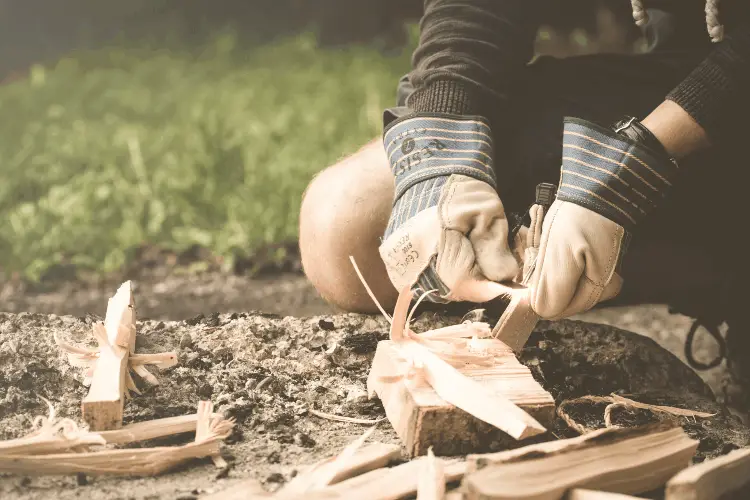
The first step is to start the fire going with a tinder or firestarter.
The first step with this technique is to get the fire going with a firestarter and tinder. You need to have enough heat, right?
Once you have the embers started, you can use your mouth to blow air onto the area. The sweet spot for blowing on embers is 12-18 inches away from the intended target.
If you go too far away, your blowing will not do anything. If you are too close, the embers could blow out or burning particles could shoot back up at your face.
Also, note that our breath contains water vapor. That water vapor is counterproductive for the fire, so be careful.
Keep blowing and adding more fuel until the fire can burn without any assistance. It just needs enough oxygen. This will take some time, so be patient and stick to the process.
Bellows
You may have seen a bellow in your grandfather's attic, but they can actually be used to start fires in the wild. Just like a leaf blower.
Essentially, you are taking your lungs and replacing them with a machine that can be more efficient and less taxing on your body.
The machine known as bellows is built up of a bag with two wooden handles. You pump the handles and push air out of the bag.
So, instead of having to work out your lungs, you can work out your arms. And build some muscle.
Like the blowing method, once you get some embers going, use the bellows to pump air into the system until it can survive on its own.
Although bellows were popular many years ago and can be found in many antique shops, there are a few newer ones available on Amazon.
So, you can use a new tool rather than an antique at your campsite.
Fan
Alongside blowing, the fan method is the most practical to use in the field. You really don’t even need a legitimate fan to do this technique, but having one certainly helps.
You can buy a specific fan for the job, but usually, using a magazine, book, paper plate, or anything of the sort can be used well.
When you finally get those embers going with your tinder, wave the fan gently enough to push air in without making it too forceful. It will surely make the fire burn.
A great way to use the fan method effectively is to actually start with the blowing technique until your embers are strong enough for the fan. This ensures that the lighting will be successful and you do not spoil your embers.
The size of your “fan” will determine how close you fan to the fire. The bigger your fan, the further away from the fire you can start the process. If your fan is smaller, you will want to be closer to the frame.
I particularly find that a leaf blower works better.
Fire blowing tools (foot pump)
The final section of tools to blow on a fire is the foot pump method as well as any other fire blowing tools out on the market such as a leaf blower.
A foot pump is yet another way for you to push air from you to the fire.
Instead of having to get down next to the fire, you can affix a foot pump that lets you step on the apparatus and give that fire some life.
Generally, there is a stepping box that refills itself of air and uses a hose or spout to push air into the fire. These are very similar to the bellows, but you use your feet instead of your hands.
There are some other tools and machines that can get the job done such as air compressors and one-off items.
This wraps up the techniques for blowing on a fire!
Of all of these, my favorite technique is blowing. There is something primal and real about getting on my hands and knees to blow on a fire.
This also lets me control exactly how much air is going into the fire. It takes a bit of practice, but this puts me in a good space to get that fire roaring.
Conclusion
I hope by now you have an answer to the question “why does blowing on a fire make it burn better.”
As you can see, there are a number of ways and aspects of blowing on a fire. There are no hard and fast rules, but using these tips will put you in a great spot to have an awesome fire.
Keeping the fire triangle in mind, you now know the importance of inserting oxygen into a fire.
When you can create that mini vacuum, more and more air will find its way into the fire and keep it burning for longer.
Also keep in mind the techniques used to get oxygen into the fire’s structure. Using the blowing method, bellows, a fan, a leaf blower, a foot pedal, and a few others will help you get the job done well.
Overall, blowing on a fire makes it burn better. Be sure to implement these tips and tricks into your life the next time you camp!
Asen Stoyanchev
Founder of this website, Asen is a passionate hiker and writer who is also a gear nerd. He’s been featured on many established hiking websites where he gives hiking advice & tips. When he is not trekking with his family or friends, he is writing articles and product reviews. Asen spends most of his time in Bulgaria but he constantly travels the world in seek of more unforgettable experiences. Read more about Asen here.

![Why Does Blowing On A Fire Make It Burn Better? [See Why] why does blowing on a fire make it burn better](https://gearuphiking.com/wp-content/uploads/2021/06/why-does-blowing-on-a-fire-make-it-burn-better.jpg)
